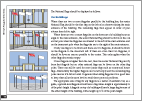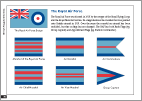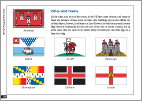British Flags & Emblems
The book is now available to buy online from the Flag Institute's website. It costs £15 for UK buyers and US$30 for overseas buyers, both including P&P.
Review
"The tale grew in the telling", as the saying goes. Way back in 2000 Graham Bartram, the General Secretary of the Flag Institute, decided it would be a good idea to have a guide to flying flags in Britain ready for 2001, the bicentenary of the modern Union Flag. It was going to be a 16-page pamphlet. Well, he missed the 2001 deadline, but that has turned out to be a real bonus, because the end result is a little larger - at 128 pages! 'British Flags and Emblems' started as a simple guide but has developed into the most comprehensive reference work to the flags and emblems of modern Britain. It is also the Flag Institute's first ever published book.
Bartram has aimed the book at a very wide audience, from government officials to schoolchildren and from flag enthusiasts to anyone with an interest in Britain. As he is the flag consultant to several UK Government departments, including the Foreign and Commonwealth Office and Ministry of Defence, he understood the need for an up to date and accurate flag protocol book for official use. Furthermore there has not been a book written specifically about British flags for many years. But he did not stop there and has created a compendium not just of the flags of Britain, but of many other emblems as well, such as Royal Arms and rank insignia, some commonplace and some obscure.
Bartram consulted very many people in preparing the book, from Flag Institute members (including myself) to Buckingham Palace, the College of Arms and the Office of the Lord Lyon. His Royal Highness Prince Philip Duke of Edinburgh made several suggestions, and graciously agreed to write the foreword to the book.
The first part of the book includes a short history of the Union Flag and the other British national flags, a technical specification for the Union Flag and British flag protocol. It covers how to fly flags on buildings, in parades, over streets, on vehicles and at half-mast, and has illustrations for each point.
 |
 |
 |
 |
 |
 |
Click a page to enlarge it
There is a chapter on the flags and emblems of the Royal Family, including all the Royal Banners (Standards) from Her Majesty The Queen to His Royal Highness Prince Harry. The recently matriculated Scottish Royal Standards are included, as are the Royal Arms and Scottish Royal Arms in their various forms used today.
The Armed Forces, including the cadet forces, are covered in great detail. Each Service has its own entry with their main flags and ensigns, including rank and appointment flags, and in the case of the Army a selection of individual regiments' camp flags. This section also includes military aircraft markings and examples of each type of ceremonial Colour, as well as the Standards of veterans' organizations.
The flags of the government, emergency services, heritage organizations, regions, counties, cities, religious organizations, youth organizations and award flags are all covered. Traditional heraldic flags, the banner and standard, and flags used in the Scottish clan system, have their own chapter.
The chapter on flags at sea covers the rules for flying flags afloat, and is splendidly illustrated with flags of maritime organizations, and the ensigns and burgees of all British yacht clubs permitted to authorise the wearing of special ensigns by members' yachts. Signal flags both civilian and military are shown, along with examples of their meanings. This section should prove immensely popular and useful to the worldwide yachting fraternity.
The rank insignia chapter includes royalty, the peerage, the Royal Navy, Army, and Royal Air Force, together with Her Majesty's Coastguard, Her Majesty's Customs & Excise, the Merchant Navy and the police, fire and ambulance services. I cannot think of any other publication which has brought all these emblems together ever before. This is a real coup.
The final part of the book includes the national anthems, plants and mottoes of each of the four countries that make up the United Kingdom, whilst the appendices give the orders of precedence in flags, the flags of the international organizations to which the United Kingdom belongs and, finally, the national flags of every country in the world.
This beautifully illustrated and fascinating book breaks new ground. Nowhere else is so much British emblematic detail to be found between one set to covers. Indeed I would be at a loss to find much of what the book contains even on the Internet. I cannot imagine anyone involved with national matters, where protocol and diplomacy are important, not rushing to obtain this book, which should be kept close to hand with other established works of reference. This has been a tremendous labour of love for Bartram and he may be justly proud of his achievement. Everybody even remotely interested in British flags and emblems must put this book on their birthday list immediately.
Malcolm Farrow
Chairman, The Flag Institute
ISBN 1-86232-297-X
A5 landscape 128pp colour, 749 colour illustrations
Published by Tuckwell Press
Flag Drawings © Graham Bartram, portions © The Flag Institute & Mario Fabretto
